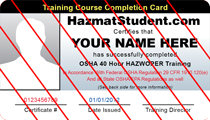The OSHA HAZWOPER standard 29 CFR 1910.120 is complex and often difficult to comprehend.
Below is a list of HAZWOPER definitions, terms and commonly referenced rules that will help you understand the HAZWOPER requirements better.
The OSHA HAZWOPER standard 29 CFR 1910.120 is complex and often difficult to comprehend.
Below is a list of HAZWOPER definitions, terms and commonly referenced rules that will help you understand the HAZWOPER requirements better.
Feel free to: 1) Link to this Page 2) Share this page on Social Media
For OSHA HAZWOPER training courses, visit:
Annual HAZWOPER refresher training requirement for all employees, management and supervisors who were required to take the initial 24 Hour HAZWOPER or 40 Hour HAZWOPER training.
Training level required for workers occasionally on-site for limited tasks and who are unlikely to exposed above the permissible exposure limits and published exposure limits. On-site management and supervisors of workers under this requirement must also take 24 Hour HAZWOPER training.
Training level required for general site workers involved in hazardous substances removal or who engage in activities that may potentially expose them to hazardous substances and health hazards. Supervisors and on-site management of these workers must also take this 40 Hour HAZWOPER training.
A system of organizing employees into work groups so that each employee of the work group is observed by at least one other employee in the work group. The purpose of the buddy system is to provide immediate assistance to employees if an emergency situation arises.
Operations where hazardous substances are removed, contained, incinerated, neutralized, stabilized, cleared-up to make a site safer for people or the environment.
Federal legislation that provided broad federal authority to cleanup abandoned and uncontrolled hazardous waste sites and hazardous substances releases not covered by RCRA. CERCLA was amended by the Superfund Amendments and Reauthorization Act (SARA).
Removal of hazardous substances and contaminants from employees and equipment in order to avoid adverse health effects.
Response by employees from outside an immediate release area or by other designated responders to an uncontrolled release of a hazardous substance.
The organized response by emergency responders to a hazardous waste spill or leak.
Federal agency created to protect human health and the environment through making and enforcing regulations.
Any chemical which poses either a physical hazard or health hazard.
An organized group of employees, designated by their employer, that handles and controls hazardous substance leaks or spills, and may require a close approach to the hazardous substance.
Any substance defined under HAZWOPER 1910.120(a)(3)(A-D) which could adversely impact the health or safety of employees.
Waste or combination of wastes as defined in OSHA 40 CFR 261.3 or substances defined as hazardous wastes in OSHA 49 CFR 171.8.
Any operation conducted within the scope of OSHA HAZWOPER 1910.120.
Standards issued by OSHA to protect HAZMAT workers involved in: Hazardous waste treatment, storage, and disposal; Hazardous waste cleanup operations; and Emergency response operations where hazardous materials are present.
An area where hazardous waste operations take place.
For OSHA mandated training, OSHA does not certify courses or provide OSHA certification of the course. The term HAZWOPER certification generally refers to a course designed by OSHA Certified Outreach trainers where a certificate of course completion will be provided.
HAZWOPER is an acronym that stands for Hazardous Waste Operations and Emergency Response.
OSHA 29 CFR 1910.120 provides the standards and training for hazardous waste operations and emergency response for various employees and their job responsibilities. OSHA has provided a HAZWOPER FactSheet with succinct overview of the HAZWOPER training levels and requirements.
For hazardous waste site clean-up operations, OSHA 29 CFR 1910.120(e) provides training requirements for general site workers, occasional site workers and their management and supervisors, which vary based on job duty and may include 40 Hour HAZWOPER training, 24 Hour HAZWOPER training, 8 Hour HAZWOPER refresher training, field experience and specialized supervisor training.
A chemical or a pathogen where exposed employees may incur acute or chronic health effects.
An atmospheric concentration of any toxic, corrosive, or asphyxiant substance that poses an immediate threat to life or would interfere with the ability to escape from a dangerous atmosphere.
Organization created in 1970 as part of the Occupational Safety and Health Act. OSHA creates and enforces worker safety standards and regulations that employers must follow.
The exposure, inhalation, or dermal exposure limit specified in OSHA 29 CFR Part 1910, Subparts G and Z.
Emergency response performed after the immediate threat of a hazardous substance release has been stabilized or eliminated and cleanup of the site has begun.
Federal law issued by the Environmental Protection Agency (EPA) that regulates the operations that generate, treat, store, or dispose of hazardous waste.
The person at a hazardous waste site who has the authority and knowledge necessary to implement a site safety and health plan and verify compliance with safety and health requirements.
Amendments to the Comprehensive Environmental Response, Compensation, and Liability Act (CERCLA) which funded hazardous waste cleanup operations and charged OSHA with establishing standards for worker protection at hazardous waste sites.
An uncontrolled hazardous waste site, identified by a governmental agency, where an accumulation of hazardous substances creates a threat to the health and safety of people and/or the environment.
Employer-required program for employees involved in hazardous waste operations to identify, evaluate, and control safety and health hazard and emergency response.
See our HAZWOPER training courses available at: HAZWOPER Training Online or HAZWOPER Training Classroom

